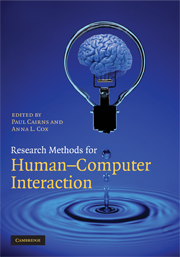Book contents
- Frontmatter
- Contents
- List of figures
- List of tables
- List of contributors
- Preface
- 1 Controlled experiments
- 2 Questionnaires, in-depth interviews and focus groups
- 3 Eyetracking in HCI
- 4 Cognitive modelling in HCI research
- 5 Formal analysis of interactive systems: opportunities and weaknesses
- 6 Using statistics in usability research
- 7 A qualitative approach to HCI research
- 8 Methodological development
- 9 Theoretical analysis and theory creation
- 10 Write now!
- 11 Applying old research methods to new problems
- References
- Index
9 - Theoretical analysis and theory creation
Published online by Cambridge University Press: 05 April 2016
- Frontmatter
- Contents
- List of figures
- List of tables
- List of contributors
- Preface
- 1 Controlled experiments
- 2 Questionnaires, in-depth interviews and focus groups
- 3 Eyetracking in HCI
- 4 Cognitive modelling in HCI research
- 5 Formal analysis of interactive systems: opportunities and weaknesses
- 6 Using statistics in usability research
- 7 A qualitative approach to HCI research
- 8 Methodological development
- 9 Theoretical analysis and theory creation
- 10 Write now!
- 11 Applying old research methods to new problems
- References
- Index
Summary
The initial impetus for research is the search for theory.
Fawcett and Downs, 1986Overview
A chapter on theory as a research technique is strange as, in a way, what is academic research about if it is not about theory? Without theory we may be engaged in product development, or data gathering, but not research. This said, there is of course also a spiritus mundi against theory: in abstracting away from the particular, theory is seen as at best simplistic and at worst reductionist and dangerous. And of course in popular language a theory is an unsubstantiated guess, almost the opposite of the scientific understanding of theory!
A theoretical approach is also not so much a method or technique that is applied to research, but an attitude and a desire to make sense of and to understand, in some ordered way, the phenomena around us. This approach can influence design and research methodology; indeed those most avowedly atheoretical in their methods are often most theoretical in their methodology!
Theories, that is systematic and structured bodies of knowledge, are the raw material for both research and practical design, but are also the outcomes of research and often the results of more informal reflection on experience. As we shall discuss shortly, theory is the language of generalisation, the way we move from one particular to another with confidence.
And theories can be more basic still. A tiny baby watches her moving fingers, hits out at a ball and sees it move, gradually making sense of the relation between feelings and effects; the building, testing and use of theory are as essential a part of our lives as feeding and breathing.
- Type
- Chapter
- Information
- Research Methods for Human-Computer Interaction , pp. 175 - 195Publisher: Cambridge University PressPrint publication year: 2008
- 8
- Cited by



